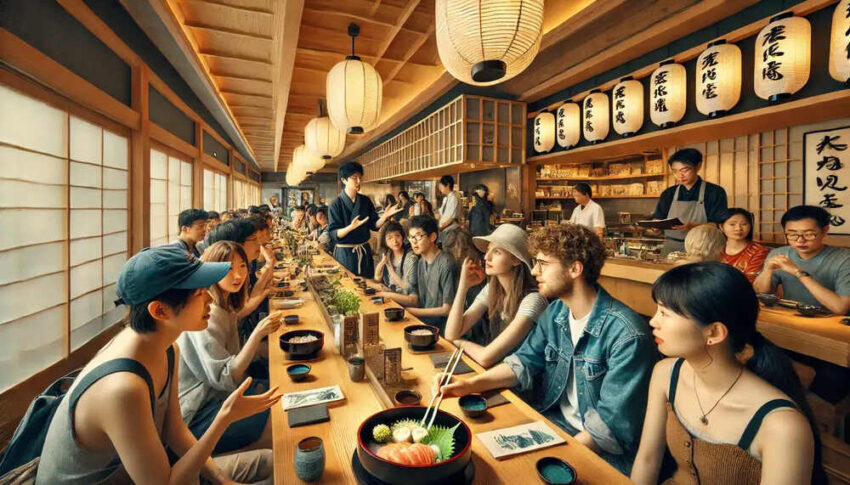Reading Time: 3 minutes
TOKYO – Japan is experiencing a trend towards a dual pricing system, with higher prices for foreigners compared to Japanese nationals and residents. As the COVID-19 crisis has subsided, numerous tourist attractions and restaurants across the country have seen a resurgence in business, driven by an influx of foreign tourists. The recent significant depreciation of the yen has made shopping and services in Japan remarkably affordable for these visitors.
Consequently, some businesses have introduced higher prices for foreign tourists than for local customers. Industry experts emphasize the need for these businesses to clearly explain the rationale behind the differential pricing for foreigners.
In Shibuya Ward, Tokyo, a popular destination for foreign tourists, a new buffet-style seafood and barbecue restaurant named Tamatebako opened in April. The restaurant caters to both locals and tourists, offering a diverse menu featuring seafood delights. A 32-year-old visitor from Taiwan recently visited the restaurant, where staff provided explanations in English on how to enjoy the various dishes. He relished grilling scallops at his table and savoring salmon sashimi.
Tamatebako offers an all-you-can-eat course with around 60 different menu items, including tuna and ikura salmon eggs, available for both lunch and dinner on weekdays. The pricing for these meals, however, differs based on the customer’s nationality or residency status. Male foreign tourists are charged ¥7,678 for weekday lunch and ¥8,778 for dinner, inclusive of tax.
In contrast, Japanese nationals and foreign residents receive a discount of ¥1,100 on these prices. This pricing structure establishes a two-tier system, differentiating between tourists and locals. The rationale behind this price differentiation has not been explicitly stated by the restaurant.
The introduction of such a system highlights a growing trend in Japan, where businesses are increasingly adjusting prices for foreign visitors. This trend has sparked discussions among industry experts and customers, emphasizing the importance of transparency in pricing practices, especially in a country known for its hospitality and fairness.
At the restaurant, staff determine if customers are foreign tourists by assessing their ability to speak Japanese or by checking for residence cards at the entrance.
With nearly 20% of the clientele being foreigners, the restaurant ensures that one in every four to five employees on duty can speak English. This linguistic capability allows the staff to assist foreign guests in navigating the buffet area and instructing them on how to grill their food properly.
Considering a Quadruple Fee Increase
In the previous fiscal year, Himeji Castle, a World Heritage site, welcomed a record-breaking 450,000 foreign visitors. The city government of Himeji in Hyogo Prefecture has sparked debate by proposing a plan to increase the admission fee for international tourists. Currently set at ¥1,000 for individuals aged 18 and older, the fee for foreign visitors is set to rise nearly four times its current amount.
The mayor stated that the fee increase aims to generate funds for the castle’s upkeep and management. This includes financing the training of workers to preserve traditional skills, such as crafting and installing kawara roof tiles and applying shikkui plaster.
Charging different fees for foreign visitors at renowned sites or attractions is not an unusual practice internationally. For instance, the Taj Mahal in India imposes an admission fee of approximately ¥2,100 for foreign tourists, a rate that is more than 20 times higher than what Indian nationals pay. Similarly, the Louvre Museum in France charges around ¥3,800 for admission, though it is free for EU residents aged 18 to 25, and for those under 18.
In various countries, differential pricing for foreigners is a common approach to manage the high costs associated with maintaining and operating iconic landmarks. This practice helps offset the financial burden of preserving these cultural treasures while accommodating the influx of international visitors.
In Japan, the Cultural Affairs Agency and the Consumer Affairs Agency have indicated that facility owners or managers have the authority to implement a two-tier pricing system based on nationality. Despite this, the agencies noted that there are no known public facilities in Japan that have adopted such a pricing model as of now.
This flexibility allows for varying pricing strategies, but it remains unclear whether this approach will become more widespread in Japan’s public facilities. The introduction of such a system could potentially affect the accessibility and perception of cultural sites among international visitors.
As Japan considers these options, it reflects a broader trend seen globally where pricing strategies are tailored to balance financial needs with the goal of preserving cultural heritage. The debate continues on how best to implement these policies while maintaining fairness and transparency.
The post Controversy Erupts As Japanese Businesses Charge Higher Prices For Foreign Tourists appeared first on Travel And Tour World.

